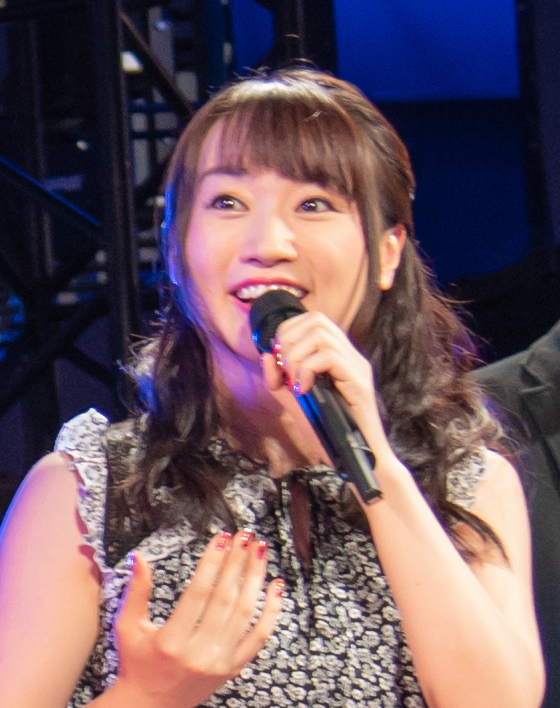
Anime song
Anime song (アニメソング, anime songu, also shortened to anison (アニソン)) is a genre of music originating from Japanese pop music. Anime songs consist of theme, insert, and image songs for anime, manga, video game, and audio drama CD series, as well as any other song released primarily for the anime market, including music from Japanese voice actors.
Anime song
The anime song genre was first defined as a musical category in the 1970s. It later gained popularity from the public when mainstream artists begin releasing songs as tie-ins for anime series. By the 1990s, it became redefined as a separate genre when companies began creating record labels that would exclusively produce anime songs for their series and artists. The increase in voice actors beginning in the mid-2000s led to growing market interest in the genre.
History[edit]
1930–1970: Early influences[edit]
The Dull Sword (1917), by Jun'ichi Kōuchi, is regarded as the earliest surviving animated film in Japan. Noburō Ōfuji's Kuroi Nyago (1929) is the first Japanese animated work to include music. The film includes characters dancing to a prerecorded song, retroactively seen as the prototype of anime songs.[1]
Following World War II, the 1950s and 1960s saw a revival in entertainment and cultural development.[1] In 1963, Astro Boy premiered and subsequently, the theme song "Theme of Astro Boy" became well-known to the Japanese public due to it being used as the departure song at Takadanobaba Station.[1] The song was also notable due to the lyrics being written by poet Shuntarō Tanikawa.[1]
1970–1980: Growing popularity of anime songs[edit]
Japan's economic growth in the 1970s led to more cultural development, and people who exclusively sang theme songs for anime were known as "anime song singers."[1] Despite the lack of public appearances from the singers, theme songs from the series Mazinger Z, Space Battleship Yamato, and Candy Candy became known to the Japanese public, even outside of fans who watched the shows.[1] At the same time, Mobile Suit Gundam voice actors Toshio Furukawa and Toru Furuya gained a large female fanbase with through Slapstick, a vocal unit consisting of voice actors from the show meant to its theme songs.[2][3] While anime theme songs originally used the name and settings from the series of which they were based, this led to the lyrics of anime songs being centered on the characters' thoughts and feelings for more universal appeal and allowing for context outside of the original animated work.[1]
1980–1990: Mainstream recognition[edit]
At the height of Japan's bubble economy, in the 1980s, musicians outside of the anime industry began performing theme songs for anime.[1] In 1984, the single "Ai Oboete Imasu ka", which was released for Macross under the character Lynn Minmay's name, charted at #7 on the Oricon Weekly Singles Chart.[1][4] Furthermore, Cat's Eye (1983) received widespread media attention for having Anri, a singer whose activities had no connection to the anime industry, perform its theme songs.[1] Likewise, TM Network, a band who were active outside of the anime industry, received media attention when their 1987 song "Get Wild" was released as the theme song to City Hunter.[1] As a result of the song's popularity, TM Network were invited to the 72nd Kohaku Uta Gassen to perform it.[1] From then on, mainstream artists releasing tie-in songs for anime became common.[1]
1990–2000: In-house production and modernization[edit]
Following the collapse of the bubble economy in Japan, labels exclusively dedicated to exclusively producing anime songs were formed, most notably King Records' Starchild label.[1] This was in part due the "Being Boom" phenomenon named after Being Inc., which gained a fanbase after their artists Zard and Maki Ohguro released songs that were well-received by the public.[1] Yoko Takahashi, who was part of the Starchild label, released "A Cruel Angel's Thesis" as the theme song for Neon Genesis Evangelion (1995), and the song's popularity led to audiences outside of anime fans to recognize it.[1] In addition, as popular music from Japan shifted from kayōkyoku to J-pop, anime song singers, such as Masami Okui, began incorporating J-pop sounds into her music.[1] Among others, voice actors such as Hekiru Shiina, Mariko Kouda, and Megumi Hayashibara were also active in singing in addition to voice acting.[2] Some voice actors also formed their own groups and perform theme songs to other anime series, such as Minami Takayama with Two-Mix.[5]
Derivatives[edit]
The anime song genre became the direct influence of genres such as denpa song and moe song.[5]